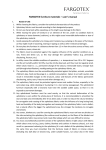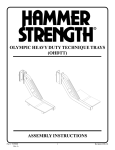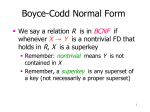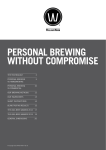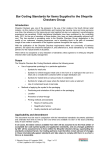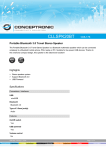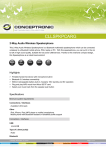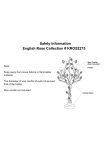Download FARGOTEX furniture materials – user`s manual
Transcript
FARGOTEX furniture materials – user’s manual I. CHENILLE FABRICS CHARACTERISTCS (e. g. Leo New, Tuborg) 1. Chenille fabric – a fabric containing the chenille yarn in the warp or/and weft. 2. Chenille fabrics are produced with the use of the most advanced production and finishing techniques. The weave of the chenille yarn makes the fabric soft and provides it with a silky shine. 3. A characteristic feature of this fabric is the irregular surface which gives a unique effect of the play of light and shadow. 4. The upholstery materials may have features similar to the upholstery fabrics, such as: sensitiveness to the touch and changing colour - variation of the shine and shade depending on the angle of light even in the same portion of the material, micro-fibers (pilling), electrifying features (pulling dust, powders, fibers etc.) 5. For the furniture fabric to retain the effect of newness for a long time, any dirt or dust must be removed immediately from the surface of the fabric. It is recommended to regularly vacuum, clean and hand comb the furniture with a soft brush, without excess friction to prevent damaging the fibers. II. FLAT WOVEN FABRICS CHARACTERISTICS (e.g. Hugo Manhattan, Oscar, Oxford, Soho) 1. The flat woven fabric is a fabric with the threats of warp and weft crossing at the right angle. While choosing the flat woven fabric, you must consider, apart from the fabric parameters, the type of fiber of which it is produced, as the fiber has a significant effect on the future features of the product. Depending on the fiber, the flat woven fabric may have the features of the other fabrics, e. g. a flat woven fabric made of chenille fibers may include pilling. III. KNITTED FABRICS CHARACERISTCS (e. g. Premium, Aruba) 1. The knitted fabric is a fabric produced through the process of knitting stitches from the threats. 6. The upholstery materials may have features similar to the upholstery fabrics, such as: sensitiveness to the touch and changing colour - variation of the shine and shade depending on the angle of light even in the same portion of the material, micro-fibers (pilling), electrifying features (pulling dust, powders, fibers etc.) 2. The characteristic feature are “mirrors of seats”, which are visible traces of the body created due to the weight, warmth and humidity of the surrounding where the furniture is operated. 3. Various ways of using the subsequent elements affect the hardness and the optical appearance of the final product. The consequential permanent loosening and creases are a typical phenomenon. IV. 1. 2. 3. 4. RULES OF USE While choosing the fabrics, consider the technical characteristics of the product. Upholstery fabrics must be used according to their designated purpose. Do not use sharp tools while unpacking, as this might cause damage to the fabric. While moving the piece of furniture or an element of the set, under no condition hold its upholstery or loose elements (cushions), as this might cause irreversible deformation or tear of the upholstery material. 5. Avoid exposing the upholstery to strong, point tensions (e.g. jumping on the piece of furniture), as they might result in loosening, tearing or ripping as well as other mechanical damages. 6. Do not place the furniture in a distance shorter than 1.5 m from the active sources of heat, such as radiators, ovens, stoves etc. 7. The fabrics must be protected against the negative influence of the weather conditions (e. g. rain, frost) and direct sun, as this may damage the upholstery fabrics (e.g. permanent discoloring, fracture, etc.) 8. In utility rooms the suitable conditions of operation, i. e. temperature from 19 to 23 C degrees and the air humidity within 50-70%, must be strictly observed, and they must be regularly aired. Other values result in, i. a., permanent change of the colours, irremovable stains, stronger dust pull (through electrification), mould growing on the upholstery fabrics, etc. 9. The upholstery fabrics must be unconditionally protected against hot plates, animals, unsuitable children’s play, food and beverage (i. a. alcohol) consumption. Failure to act with caution may result in irreversible changes to the structure, colour and features of the fabrics (permanent discolouring, stains, tears, fractures and other damages etc.). 10. The upholstery fabrics must be protected against excess and sudden friction, especially in the same place (e.g. while cleaning or by placing it in a too narrow passageway). The upholstered furniture (especially with a function) must have the suitable usable space, so that it is not exposed to permanent damages. 11. Any upholstered furniture must be used evenly, so that the natural deformation of the upholstery is even within the whole piece of furniture. It is recommendable to smoothen the seat and back area immediately after it has been used, in order to reduce the natural tendency for corrugation and creasing of the upholstery fabrics under the influence of a long lasting load, heat and humidity of the body (corrugation and creasing of the upholstery fabric is not a defect, but a natural effect, the bigger the upholstered area, the stronger the tendency to corrugate and crease). 12. Any covers, blankets etc. used for covering the upholstered fabrics must not have any bristles on the side contacting the upholstery (the surfaces must be plane), as the fibers of the blanket and the upholstery fabric may connect and create fiber pilings which are very difficult to remove. 13. You must unconditionally avoid the contact of the upholstery fabrics in light colours with fabrics which colours may run (e.g. jeans, clothes, blankets and cushions in intense colours), as it may result in a permanent colouring to the upholstery (it is not a defect of the upholstery fabrics). At the same time you must remember that the furniture made of fabrics in intense colours (including red, dark blue or brown) may, under suitable factors, run colour also in the initial stage of using, which is a natural feature of the fabrics coloured in full and you must avoid sitting on them wearing clothes in light colours. V. RULES OF FABRIC CARE 1. The upholstery fabrics must be regularly cleaned and maintained, according to the manuals attached. 2. The upholstery fabric must be kept clean. In order to protect it against dirt, the fabric must be dusted with the use of vacuum cleaner or manually, with a wet cloth. 3. The liquids must be wiped from the fabric surface with a well-absorbing material without putting any pressure. The remaining liquid must be wiped with a clean and dry material (cotton cloth, paper towel etc), with a little pressure. 4. If the liquid leaves a stain, it must be removed with a soaped cotton cloth, without spreading the stain. You must change the side of the soaped cloth after each contact with the fabric, so that the stain is not spread or rubbed in. Then, the soap must be rinsed with water. 5. Dry dirt (mud, dust, powder, cosmetics etc.) must be vacuumed from the fabric before the substance is absorbed by the fabric. If there are any remains, the dirt must be shaken of and brushed delicately with a brush. If the stain remains, it must be wept with round moves with the use of a soaped, cotton cloth. 6. For other stains you must wet a cotton cloth and soap it with a hypoallergenic soap. Then the stain must be wept with a little pressure, without spreading it. It must be done with round, delicate moves. 7. Spilt liquid must be cleaned immediately, by wiping it from the outer area of the stain towards the middle, without too much friction. 8. After the cleaning, the area around the stain must be wept with a wet cloth, so that the same level of moisture is maintained. The fabric must be dried with round moves, using a hairdryer set at low heat level. 9. Hypoallergenic soap must be used for cleaning the product. It is not recommended to use washing-up agent, liquid soap, solvent with alkaline reaction and based on kerosene and detergents used in household, such as bleacher etc. 10. Never use iron for drying the fabrics. 11. Do not use the carpet cleaning agent. 12. Regular cleaning and maintenance of the upholstery fabrics prevents permanent dirt and prolongs its lifetime. 13. All products designated to cleaning and maintenance of upholstery fabrics must be first checked on an invisible spot. The agents must be used on surfaces, applied from seam to seam. Do not rub the stained surfaces, as you may damage the fabric. For stains which got absorbed by the surface, best ask for an expert’s opinion. Do not remove the stains with solvents (bleachers, turpentine, petrol etc.). This way you may spread or consolidate the stains. VI. IMPORTANT INFORMATION ON CLEANING: Follow the cleaning manual step by step Clean the stain immediately. If the immediate cleaning of the stain is not possible, spray a small amount of water with soap on the stain, using a soft cloth. In order to remove the remains of the soap in the fabric, it must be sprinkled with water and drained until the soap is completely removed. Use the paper towel exclusively for draining, not for wiping. Microfiber clothes are recommended for cleaning. On the vertical surfaces the water must be sprayed (not spilt). While cleaning, always use the clean side of the paper towel or micro-fiber cloth. When washing the fabrics, first clean the fabric as described above and then wash it in the temperature of 30 ˚C by hand or mechanically with the “delicate washing” option. If needed, use a sponge instead of a brush. Rinse the fabric, until the soap is completely removed. Dry flat. Keeping the stain on the fabric for a long time or unsuitable methods of cleaning may make the cleaning more difficult. Tumble dryer is not recommended for complete drying of the fabric. After the cover is placed on the piece of furniture, in order to restore the initial appearance of the fabric, it must be wiped with a clean, soft micro-fiber cloth. Do not use cleaning agents other than the green soap. Do not put too much pressure on the fabric while cleaning. Do not use sharp cleaning tools such as, e.g. brushes




